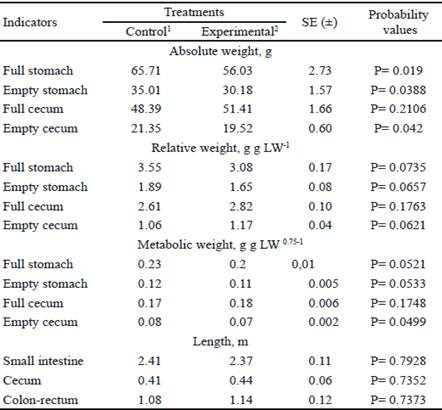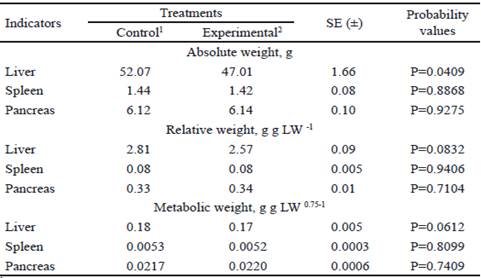Introduction
The peculiarities of the digestive system of rabbits allow to achieve a profitable use of fibrous sources in the diet, compared to other monogastric species, which may generate low productivity with this type of food (Nieves et al. 2009). These benefits, together with the increase of prices of dietary ingredients of vegetable origin, mainly alfalfa, cereals and soybean meal (FAO 2017) in the international market, require the development of unconventional feeding systems. Therefore, it is necessary to use energy and protein sources of national production that are cheaper, although animals reach a lower growth rate and more time is needed to achieve the slaughter weight (Valdivié et al. 2011).
In tropical countries, sugar cane is a food with many economic advantages, because it has no competition with any other cultivated by man, from the point of view of efficiency of solar energy capture per area (Savón 2015). The production of animal feed from sugar cane has always been considered as a real possibility for obtaining quantities of meat and milk, without the need to use imported cereals. Due to its insoluble fiber content (IF), it has a regulatory effect on gastrointestinal passage time and prevents microbial disorders. It is a plant of great acceptance by rabbits (Figueredo and Peña 2012 and La O et al. 2015), which makes it an attractive energy source for unconventional feeding of this species.
Another source is trees with good potential for forage production (Savón et al. 2017). Promising species include mulberry (Morus alba, L.), which shows great adaptability to tropical conditions and is easily integrated into livestock production systems (Vázquez and Maraví 2017). This plant also stands out because its nutritional value is one of the highest among non-leguminous tropical forages (Huahuarunta 2015, Montejo 2016 and Martín et al. 2017). In rabbits, Pinzón and Pedraza (2014) and López et al. (2014) recommend mulberry as a tropical resource with potential as an alternative protein source in the diet of this species.
The use of dietary fiber in feeds causes changes in intestinal morphology of monogastric animals. Previous studies with these animals show that the amount and physical-chemical composition of fiber can influence the development of the digestive system (Gidenne 2015).
The objective of this research was to study the morphometry of digestive organs of fattening rabbits with an alternative feeding system with mulberry forage (Morus alba) and sugar cane stems (Saccharum officinarum).
Materials and Methods
An amount of 30 male and female rabbits, from New Zealand x Chinchilla crossing, with 40 d old and mean weight between 600 ± 50 g were used for 49 d. A feeding system was evaluated, with two variants that corresponded with two treatments: T1) control diet, which included restricted feed (100 g) plus fresh forage of mulberry ad libitum and T2) experimental diet, which included fresh sugar cane stem ad libitum plus fresh forage of mulberry ad libitum and 30 g of feed/rabbit/day.
Typical galvanized wire cages were used for fattening rabbits, in which five animals belonging to the same litter were housed. Animals received water at will and pelleted feed in mud feeders. Mulberry forage belonged to YU 62 variety. It was manually cut, at 60 d of regrowth, at a height of 30 cm above soil level. It was offered in the feeders for forage, located between cages. The sugar cane used belonged to the variety Jaronú-62. The stem was offered in two times, and was placed inside the cage, clean of leaves and straws. Moments before being offered to the animals, the stem was cut into the middle to 20 cm in length.
The animals were weighed and, prior to slaughtering, were desensitized by the concussion method described by Baumans et al. (1997). They were slaughtered 2 h and 30 min after food ingestion to extract their digestive organs (Martínez et al. 2008). The abdomen was opened and the different portions of the gastrointestinal tract (GIT) were separated. The entire GIT and digestive organs (stomach, small intestine, cecum and colon-rectum) were weighed full and empty, as well as accessory organs (liver and pancreas) and the spleen. In the case of the small intestine (SI), cecum and colon-rectum, their length was also measured. Absolute (g), relative (g g LW-1) and metabolic (g g LW0.75-1) weights of the different segments and organs described above were obtained.
Analysis of variance was applied, according to completely randomized design. For the comparison of means, the F of Fisher (1935) test was used for P<0.05. For the statistical processing of data, INFOSTAT software, version 2012 (Di Rienzo et al. 2012) was used.
Results and Discussion
Table 1 shows absolute, relative and metabolic weight of different sections of the GIT (full and empty), as well as the length of the SI, cecum and colon-rectum.
Table 1 Effect on morphometry of GIT of rabbits fed mulberry forage and sugar cane stem

1100 g of feed + mulberry forage ad libitum
230 g of feed + mulberry forage ad libitum + sugar cane stem ad libitum
Rabbits fed 30 g of feed + mulberry forage ad libitum + sugar cane stem ad libitum had lower absolute weight of full and empty stomach (P <0.05). However, there were no differences in this organ with respect to relative and metabolic weights. There was a decrease in the weight of empty cecum, in the absolute weight as in the metabolic weight (P <0.05) with respect to the control of 1.83 g and 0.01 g g LW 0.75-1, respectively. The length of the SI was not affected by sugar cane stem intake, mainly because the transit time through this organ is very fast (40-100 min) and no major changes occur (Carabaño and Piquer 1998). The length of the cecum and the colon-rectum did not show differences either.
Although the values are among the ranges reported in the literature (Pérez 1990), the decrease of stomach weight could be caused by less time of stay of digesta in that organ, due to the increase of passage speed caused by the increase of IF in the diet (Gidenne and Lebas 2006) to include sugarcane. Similar performance was described by Dihigo et al. (2001), by including sugar cane meal replacing alfalfa in diets for fattening rabbits.
Regarding cecum weight, the result is consistent with digestive physiology of the rabbit and is related to the contribution of IF. A high intake of this fiber, in general, reduces passage time, which is attributed to an increase in its motility. According to Cherbut et al. (1994), this is because celluloses are responsible for grouping the contractions in the myoelectric complex.
Several authors (Savón 2005 and Dihigo et al. 2008) suggest that there is a direct relationship between the content of IF (cellulose, hemicellulose) in the diet and the passage speed of nutrients through the GIT. This increase of passage rate of digesta leads to greater emptying of the cecum and promotes higher food intake, as reported in a previous study by Vázquez et al. (2016). This performance was similar to that described by Nieves et al. (2012), when evaluating the use of fresh foliage of Tithonia diversifolia and Morus alba in the feeding of fattening rabbits.
Table 2 shows that the inclusion of the sugar cane stem did not affect absolute, relative and metabolic weight of pancreas and spleen, so it is likely that with the contribution of sugar cane IF, the specific functions of these organs will not increase. Hence, it could be inferred the presence of very few metabolic implications of a specific type with unconventional sources for the feeding of fattening rabbits. There is evidences that show an increase of the absolute weight of these organs in different animal species, from the use of other unconventional food sources, an aspect that was not expressed in this study.
Regarding the liver, absolute weight decreased (P <0.05) in the animals fed sugar cane stem (table 2). It is likely that the increase in passage speed, caused by the increase of IF in the diet, diminished the function of the liver to degrade food and, therefore, also the weight of this organ (Savón 2005 and Dihigo et al. 2008). This aspect did not deteriorate the liver glycogen deposit, as there were no differences in relation to metabolic weight and liveweight.











 text in
text in 



